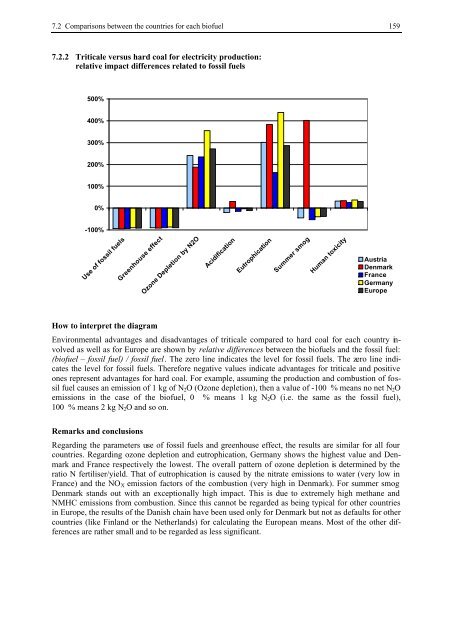BIOENERGY FOR EUROPE: WHICH ONES FIT BEST?
BIOENERGY FOR EUROPE: WHICH ONES FIT BEST?
BIOENERGY FOR EUROPE: WHICH ONES FIT BEST?
Create successful ePaper yourself
Turn your PDF publications into a flip-book with our unique Google optimized e-Paper software.
7.2 Comparisons between the countries for each biofuel 159<br />
7.2.2 Triticale versus hard coal for electricity production:<br />
relative impact differences related to fossil fuels<br />
500%<br />
400%<br />
300%<br />
200%<br />
100%<br />
0%<br />
-100%<br />
Use of fossil fuels<br />
Greenhouse effect<br />
How to interpret the diagram<br />
Ozone Depletion by N2O<br />
Acidification<br />
Eutrophication<br />
Summer smog<br />
Human toxicity<br />
Austria<br />
Denmark<br />
France<br />
Germany<br />
Europe<br />
Environmental advantages and disadvantages of triticale compared to hard coal for each country involved<br />
as well as for Europe are shown by relative differences between the biofuels and the fossil fuel:<br />
(biofuel – fossil fuel) / fossil fuel. The zero line indicates the level for fossil fuels. The zero line indicates<br />
the level for fossil fuels. Therefore negative values indicate advantages for triticale and positive<br />
ones represent advantages for hard coal. For example, assuming the production and combustion of fossil<br />
fuel causes an emission of 1 kg of N2O (Ozone depletion), then a value of -100 % means no net N2O<br />
emissions in the case of the biofuel, 0 % means 1 kg N2O (i.e. the same as the fossil fuel),<br />
100 % means 2 kg N2O and so on.<br />
Remarks and conclusions<br />
Regarding the parameters use of fossil fuels and greenhouse effect, the results are similar for all four<br />
countries. Regarding ozone depletion and eutrophication, Germany shows the highest value and Denmark<br />
and France respectively the lowest. The overall pattern of ozone depletion is determined by the<br />
ratio N fertiliser/yield. That of eutrophication is caused by the nitrate emissions to water (very low in<br />
France) and the NOX emission factors of the combustion (very high in Denmark). For summer smog<br />
Denmark stands out with an exceptionally high impact. This is due to extremely high methane and<br />
NMHC emissions from combustion. Since this cannot be regarded as being typical for other countries<br />
in Europe, the results of the Danish chain have been used only for Denmark but not as defaults for other<br />
countries (like Finland or the Netherlands) for calculating the European means. Most of the other differences<br />
are rather small and to be regarded as less significant.

















